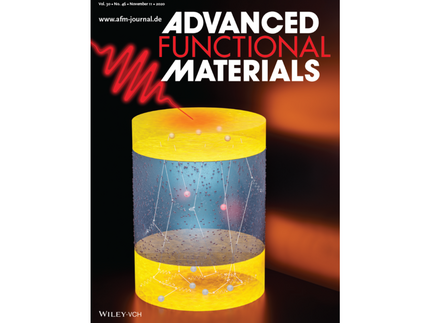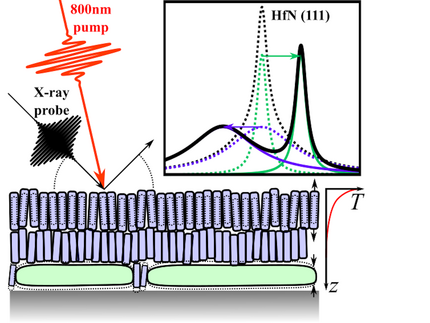Nanoscale heat transport
Understanding and utilizing the transport of thermal energy at the nanoscale via various excitations such as hot electrons, lattice vibrations and spin waves is a fundamental scientific challenge that is relevant to all research fields of the group: It touches plasmonics as the origin of the broadening of optical resonances and is highly relevant to control chemical reactivity. In ultrafast lattice dynamics, the heat transport limits the available spatio-temporal shape of the photoinduced stresses driving the strain waves. Anharmonic interactions of phonons determine phononic heat transport via Umklapp-processes and govern the nonlinear strain propagation at large amplitudes. In ultrafast magnetism, nanoscale heat enables „heat-assisted magnetic recording (HAMR)“ and it is important to calibrate the contributions to the specific heat by spins, electrons and phonons. After all, heat controls the phase transitions in magnetically ordered materials and in ferroelectrics. We believe that ultrafast control of heat and strain at the nanoscale can be exploited for the realization of ultrafast ferroelectric switching processes.
Related publications
Mattern M., von Reppert A., Zeuschner S. P., Herzog M., Pudell J.-E., and Bargheer M.
Concepts and use cases for picosecond ultrasonics with x-rays
Photoacoustics 31, 100503 (2023).
This review discusses picosecond ultrasonics experiments using ultrashort hard x-ray probe pulses to extract the transient strain response of laser-excited nanoscopic structures from Bragg-peak shifts. This method provides direct, layer-specific, and quantitative information on the picosecond strain response for structures down to few-nm thickness. We model the transient strain using the elastic wave equation and express the driving stress using Grüneisen parameters stating that the laser-induced stress is proportional to energy density changes in the microscopic subsystems of the solid, i.e., electrons, phonons and spins. The laser-driven strain response can thus serve as an ultrafast proxy for local energy-density and temperature changes, but we emphasize the importance of the nanoscale morphology for an accurate interpretation due to the Poisson effect. The presented experimental use cases encompass ultrathin and opaque metal-heterostructures, continuous and granular nanolayers as well as negative thermal expansion materials, that each pose a challenge to established all-optical techniques.
This publication is part of the Special Issue Ultrafast Photoacoustics.
Zeuschner S. P., Wang X.-G., Deb M., Popova E., Malinowski G., Hehn M., Keller N., Berakdar J., and Bargheer M.
Standing spin wave excitation in Bi:YIG films via temperature-induced anisotropy changes and magneto-elastic coupling
Physical Review B 106, 134401 (2022).
Based on micromagnetic simulations and experimental observations of the magnetization and lattice dynamics after the direct optical excitation of the magnetic insulator Bi : YIG or indirect excitation via an optically opaque Pt/Cu double layer, we disentangle the dynamical effects of magnetic anisotropy and magneto-elastic coupling. The strain and temperature of the lattice are quantified via modeling ultrafast x-ray diffraction data. Measurements of the time-resolved magneto-optical Kerr effect agree well with the magnetization dynamics simulated according to the excitation via two mechanisms: the magneto-elastic coupling to the experimentally verified strain dynamics and the ultrafast temperature-induced transient change in the magnetic anisotropy. The numerical modeling proves that, for direct excitation, both mechanisms drive the fundamental mode with opposite phase. The relative ratio of standing spin wave amplitudes of higher-order modes indicates that both mechanisms are substantially active.
Herzog M., von Reppert A., Pudell J.-E., Henkel C., Kronseder M., Back C. H., Maznev A., and Bargheer M.
Phonon-dominated energy transport in purely metallic heterostructures
Advanced Functional Materials 32, 2206179 (2022).
We use ultrafast x-ray diffraction to quantify the transport of energy in laser-excited nanoscale Au/Ni bilayers. Electron transport and efficient electron-phonon coupling in Ni convert the laser-deposited energy in the conduction electrons within a few picoseconds into a strong non-equilibrium between hot Ni and cold Au phonons at the bilayer interface. Modeling of the subsequent equilibration dynamics within various two-temperature models confirms that for ultrathin Au films the thermal transport is dominated by phonons instead of conduction electrons because of the weak electron-phonon coupling in Au.
Mattern M., von Reppert A., Zeuschner S., Pudell J.-E., Kühne F., Diesing D., Herzog M., and Bargheer M.
Electronic energy transport in nanoscale Au/Fe hetero-structures in the perspective of ultrafast lattice dynamics
Applied Physics Letters 120, 092401 (2022).
We study the ultrafast electronic transport of energy in a photoexcited nanoscale Au/Fe hetero-structure by modeling the spatiotemporal profile of energy densities that drives transient strain, which we quantify by femtosecond x-ray diffraction. This flow of energy is relevant for intrinsic demagnetization and ultrafast spin transport. We measured lattice strain for different Fe layer thicknesses ranging from few atomic layers to several nanometers and modeled the spatiotemporal flow of energy densities. The combination of a high electron-phonon coupling coefficient and a large Sommerfeld constant in Fe is found to yield electronic transfer of nearly all energy from Au to Fe within the first hundreds of femtoseconds.
This article is part of the APL special issue "Spintronics" and was highlighted as "Editor's Pick".
S. P. Zeuschner, J.-E. Pudell, M. Mattern, M. Rössle, M. Herzog, A. Baldi, S.H. C. Askes, M. Bargheer
Unveiling the Nanomorphology of HfN thin Films by Ultrafast Reciprocal Space Mapping
Advanced Optical Materials 12, 2400939 (2024).
Hafnium Nitride (HfN) is a promising and very robust alternative to gold for applications of nanoscale metals. Details of the nanomorphology related to variations in strain states and optical properties can be crucial for applications in nanophotonics and plasmon-assisted chemistry. Ultrafast reciprocal space mapping (URSM) with hard X-rays is used to unveil the nanomorphology of thin HfN films. Static high-resolution X-ray diffraction reveals a twofold composition of the thin films being separated into regions with identical lattice constant and similar out-of-plane but hugely different in-plane coherence lengths. URSM upon femtosecond laser excitation reveals different transient strain dynamics for the two respective Bragg peak components. This unambiguously locates the longer in-plane coherence length in the first 15 nm of the thin film adjacent to the substrate. The transient shift of the broad diffraction peak displays the strain dynamics of the entire film, implying that the near-substrate region hosts nanocrystallites with small and large coherence length, whereas the upper part of the film grows in small columnar grains. The results illustrate that URSM is a suitable technique for non-destructive and depth-resolved investigations of the morphology of nanostructures.
Pudell J.E., Mattern M., Hehn M., Malinowski G., Herzog M., and Bargheer M.
Heat Transport without Heating?—An Ultrafast X‐Ray Perspective into a Metal Heterostructure
Advanced Functional Materials 30, 2004555 (2020).
Rewarded as Inside Back Cover article:
Advanced Functional Materials 30, 2070304 (2020).
When the spatial dimensions of metallic heterostructures shrink below the mean free path of its conduction electrons, the transport of electrons and hence the transport of thermal energy by electrons continuously changes from diffusive to ballistic. Electron–phonon coupling sets the mean free path to the nanoscale and the time for equilibration of electron and lattice temperatures to the picosecond range. A particularly intriguing situation occurs in trilayer heterostructures combining metals with very different electron–phonon coupling strength: Heat energy deposited in few atomic layers of Pt is transported into a nanometric Ni film, which is heated more than the Cu film through which the heat is released. Femtosecond pump‐probe experiments with hard X‐ray pulses provide a layer‐specific probe of the heat energy. A purely diffusive two‐temperature model with increased thermal conductivity of hot electrons excellently reproduces the observed signals from all three layers. At the time when the Ni lattice is maximally heated, no significant heat has entered the Cu lattice. This phenomenon would be enhanced in thinner layers where ballistic transport dominates. In this context it is shown that purely diffusive transport can lead to a linear time‐to‐length dependence that must not be misinterpreted as ballistic transport.
Sarhan R. M., Koopman W., Pudell J.-E., Stete F., Rössle M., Herzog M., Schmitt C. N. Z., Liebig F., Koetz J., and Bargheer M.
Scaling up Nanoplasmon Catalysis: The Role of Heat DIssipation
The Journal of Physical Chemistry C 123, 9352 (2019).
Nanoscale heating by optical excitation of plasmonic nanoparticles offers a new perspective of controlling chemical reactions, where heat is not spatially uniform as in conventional macroscopic heating but strong temperature gradients exist around microscopic hot spots. In nanoplasmonics, metal particles act as a nanosource of light, heat, and energetic electrons driven by resonant excitation of their localized surface plasmon resonance. As an example of the coupling reaction of 4-nitrothiophenol into 4,4′-dimercaptoazobenzene, we show that besides the nanoscopic heat distribution at hot spots, the microscopic distribution of heat dictated by the spot size of the light focus also plays a crucial role in the design of plasmonic nanoreactors. Small sizes of laser spots enable high intensities to drive plasmon-assisted catalysis. This facilitates the observation of such reactions by surface-enhanced Raman scattering, but it challenges attempts to scale nanoplasmonic chemistry up to large areas, where the excess heat must be dissipated by one-dimensional heat transport.
Pudell J.-E., Maznev A. A., Herzog M., Kronseder M., Back C. H., Malinowski G., Reppert A. v., and Bargheer M.
Layer specific observation of slow thermal equilibration in ultrathin metallic nanostructures by femtosecond X-ray diffraction
Nature Communications 9, 3335 (2018).
Ultrafast heat transport in nanoscale metal multilayers is of great interest in the context of optically induced demagnetization, remagnetization and switching. If the penetration depth of light exceeds the bilayer thickness, layer-specific information is unavailable from optical probes. Femtosecond diffraction experiments provide unique experimental access to heat transport over single digit nanometer distances. Here, we investigate the structural response and the energy flow in the ultrathin double-layer system: gold on ferromagnetic nickel. Even though the excitation pulse is incident from the Au side, we observe a very rapid heating of the Ni lattice, whereas the Au lattice initially remains cold. The subsequent heat transfer from Ni to the Au lattice is found to be two orders of magnitude slower than predicted by the conventional heat equation and much slower than electron–phonon coupling times in Au. We present a simplified model calculation highlighting the relevant thermophysical quantities.









